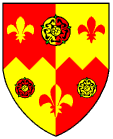
LIVES OF THE BISHOPS OF EXETER
MYLES COVERDALE, S.T.P., born near Middleham, in Yorkshire, had been a Religious of the Augustinian Convent at Cambridge (now occupied by the Physic Garden of its University), but releasing himself from his solemn vows, became a, zealous instrument of the Reformation. In Thomas, Lord Crumwell, he found a powerful abettor: his labours in translating and editing the Bible in 1535, must place him among the leading scholars of the times; as a preacher, he was celebrated at home and abroad. In the insurrection throughout this diocese in 1549, he received a license, with Doctors Gregory and Reynolds, from the infant King, to declare the Word of God to the people, in such public places as Lord John Russell, the general sent down to oppose the insurgents, should appoint ('Strype,' vol. ii. p. 168). The very day - 14th August, 1551 - which witnessed the deprivation of Bishop Vesey, saw Dr. Coverdale appointed his successor, with power from the Crown to ordain and promote clerks to holy orders and priesthood. His consecration took place, according to the new form, on 30th August, 1551, at Croydon, by Archbishop Cranmer. "The bones of his see had been so clean picked," says Heylin, p. 101, "that he could not easily leave them with less flesh than he found upon them." It is remarkable, that his Register commences on 10th September, the very day he obtained his dispensation from the young King, for himself and his wife, Elizabeth, "pro carnibus edendis," during Lent, and every fasting day, for the remainder of their lives. Four days after this royal indulgence, we find him at the Palace at Exeter, where, on 20th December that year, he ordained four deacons; one of whom, Anthony Randall, he commissioned, two days later, to expound and preach the Word of God in Latin, or English, in any church, or other decent places, throughout the diocese. Two of the other three deacons he promoted to priesthood in the chapel (sacello) of his palace. On 1st January, 1552, he ordained, "infra domum suam," John Grosse deacon and likewise priest "in uno et eodem die." His other ordinations were conducted in his cathedral: viz., 3rd July, 1552, of two deacons; on 24th of the same month, of one deacon; and on 22nd May, 1553, of two deacons: one of whom, Thomas Richards, he promoted to priesthood also "in uno et eodem die." This abuse was subsequently forbidden, viz. 1603, by the 32nd canon.
We regret that the venerable man should have consented to sit as a judge to try Von Parris, the Dutch surgeon of London, who was committed to the flames in April, 1551, for maintaining Socinian opinions. If he and Archbishop Crammer, who pronounced sentence on the unfortunate man, claimed for themselves the inherent right of changing and upholding their religious belief, how unjust to punish others for asserting the same liberty!
It must have been painful to the bishop's feelings, if he entertained any interest in the credit of his cathedral, to have been joined in the king's commission with Sir Peter Carewe and Sir Thomas Denys, knights, William Hurst, the mayor of Exeter, and John Hydwynter, one of its aldermen, to summon peremptorily his Dean and Chapter to appear before them in his palace on 30th September, 1552, "then and there to answer all demands and questions concerning the jewells, plate and other ornaments of your cathedrall churche." The summons is dated on the previous 29th August.
At Queen Mary's accession, he was deprived of his see, but by a proper Act of Council was permitted to go to Denmark "with two of his servants, his bagges and baggage, without any unlawfull lette or serche" ('Archæolog.? vol. xviii. p. 183). During his absence from England, we imagine that he translated into English the treatise on the Eucharist "Compiled by John Calvine, a man of no less learnyng and literature than godly studye and example of lyvyng; wher unto is added the Order that the churche of Christe in Denmarke, and in many places, countries, and cities of Germany doth use, not onelye at the Holye Supper of the Lorde, but also at the ministration of the blessed Sacramente of Baptisme and Holy Wedlocke," - octavo, black letter, without place, printer's name, or date. After Mary's death he returned to England, and might have been restored to his bishopric; but he preferred to lead a private life. Dr. Grindal, Bishop of London, collated him to the Rectory of St. Magnus, London Bridge, but he was too poor to pay the first-fruits, 60l. 16s. 10d., and at length, says Strype ('Hist. Reform.' p. 367), Queen Elizabeth was induced to forgive him that debt. He died, it is said, on 20th May, 1565, but perhaps on 19th February, 1568, aged 81, and was buried in the chancel of St. Bartholomew's Church, behind the Exchange, London. "His funeral was graced with the presence of the Duchess of Suffolk, the Earl of Bedford, and many honourable and worshipful persons," says Hoker, who probably wrote his epitaph. For a list of his works we refer the reader to Chalmers' 'Biographical Dictionary,' and Cooper's 'Athenas Cantabrigienses,' vol. i., but of the 'Spiritual Perle,' he was merely the translator, from the German of Otho Wormulerus, in 1550, reprinted in 1812.
Arms: - Quarterly per fess indented gules and or; in chief a Rose between two Fleurs-de-lis; in base a Fleur-de-lis between two Roses, all counterchanged.
